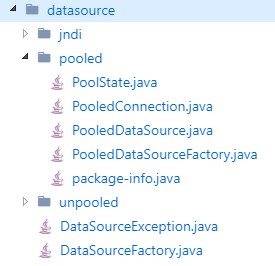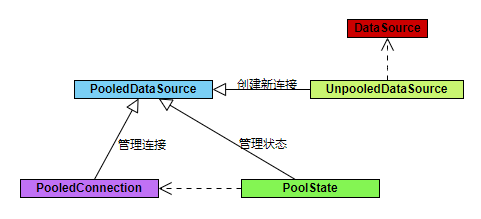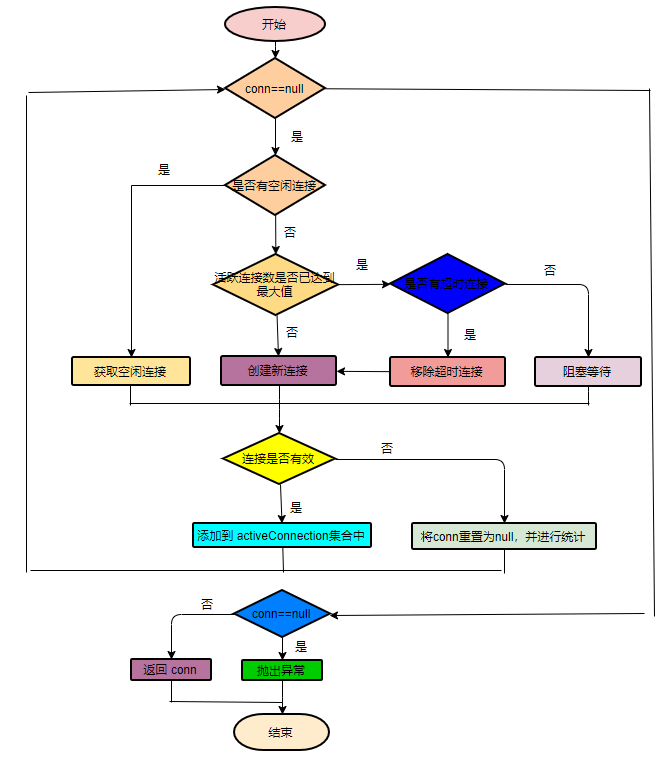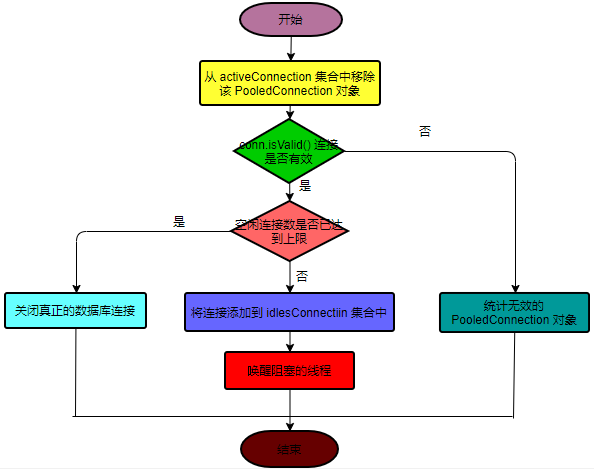原 荐 Mybatis 数据源和数据库连接池源码解析(DataSource)
Mybatis 解析配置文件的源码解析
Mybatis 类型转换源码分析
前言
在使用 Mybatis 的时候,数据库的连接一般都会使用第三方的数据源组件,如 C3P0,DBCP 和 Druid 等,其实 Mybatis 也有自己的数据源实现,可以连接数据库,还有连接池的功能,下面就来看看 Mybatis 自己实现的数据源头和连接池的一个实现原理。
类图
Mybatis 数据源的实现主要是在 datasource 包下:

我们常见的数据源组件都实现了 Javax.sql.DataSource 接口,Mybatis 也实现该接口并且提供了两个实现类 UnpooledDataSource 和 PooledDataSource 一个使用连接池,一个不使用连接池,此外,对于这两个类,Mybatis 还提供了两个工厂类进行创建对象,是工厂方法模式的一个应用,首先来看下它们的一个类图:

关于上述几个类, PooledDataSource 和 UnpooledDataSource 是数据源实现的主要逻辑,代码比较复杂,放在后面来看,现在先看看看两个工厂类 。
DataSourceFactory
先来看看 DataSourceFactory 类,该类是 JndiDataSourceFactory 和 UnpooledDataSource Factory 两个工厂类的顶层接口,只定义了两个方法,如下所示:
public interface DataSourceFactory {
// 设置 DataSource 的相关属性,一般在初始化完成后进行设置
void setProperties(Properties props);
// 获取数据源 DataSource 对象
DataSource getDataSource();
}
UnpooledDataSourceFactory
UnpooledDataSourceFactory 主要用来创建 UnpooledDataSource 对象,它会在构造方法中初始化 UnpooledDataSource 对象,并在 setProperties 方法中完成对 UnpooledDataSource 对象的配置
public class UnpooledDataSourceFactory implements DataSourceFactory {
// 数据库驱动前缀
private static final String DRIVER_PROPERTY_PREFIX = "driver.";
private static final int DRIVER_PROPERTY_PREFIX_LENGTH = DRIVER_PROPERTY_PREFIX.length();
// 对应的数据源,即 UnpooledDataSource
protected DataSource dataSource;
public UnpooledDataSourceFactory() {
this.dataSource = new UnpooledDataSource();
}
// 对数据源 UnpooledDataSource 进行配置
@Override
public void setProperties(Properties properties) {
Properties driverProperties = new Properties();
// 创建 DataSource 相应的 MetaObject
MetaObject metaDataSource = SystemMetaObject.forObject(dataSource);
// 遍历 properties 集合,该集合中存放了数据源需要的信息
for (Object key : properties.keySet()) {
String propertyName = (String) key;
// 以 "driver." 开头的配置项是对 DataSource 的配置,记录到 driverProperties 中
if (propertyName.startsWith(DRIVER_PROPERTY_PREFIX)) {
String value = properties.getProperty(propertyName);
driverProperties.setProperty(propertyName.substring(DRIVER_PROPERTY_PREFIX_LENGTH), value);
} else if (metaDataSource.hasSetter(propertyName)) { // 该属性是否有 set 方法
// 获取对应的属性值
String value = (String) properties.get(propertyName);
// 根据属性类型进行类型的转换,主要是 Integer, Long, Boolean 三种类型的转换
Object convertedValue = convertValue(metaDataSource, propertyName, value);
// 设置DataSource 的相关属性值
metaDataSource.setValue(propertyName, convertedValue);
} else {
throw new DataSourceException("Unknown DataSource property: " + propertyName);
}
}
// 设置 DataSource.driverProerties 属性值
if (driverProperties.size() > 0) {
metaDataSource.setValue("driverProperties", driverProperties);
}
}
// 返回数据源
@Override
public DataSource getDataSource() {
return dataSource;
}
// 类型转
private Object convertValue(MetaObject metaDataSource, String propertyName, String value) {
Object convertedValue = value;
Class<?> targetType = metaDataSource.getSetterType(propertyName);
if (targetType == Integer.class || targetType == int.class) {
convertedValue = Integer.valueOf(value);
} else if (targetType == Long.class || targetType == long.class) {
convertedValue = Long.valueOf(value);
} else if (targetType == Boolean.class || targetType == boolean.class) {
convertedValue = Boolean.valueOf(value);
}
return convertedValue;
}
}
JndiDataSourceFactory 依赖 JNDI 服务器中获取用户配置的 DataSource,这里可以不看。
PooledDataSourceFactory
PooledDataSourceFactory 主要用来创建 PooledDataSource 对象,它继承了 UnpooledDataSource 类,设置 DataSource 参数的方法复用UnpooledDataSource 中的 setProperties 方法,只是数据源返回的是 PooledDataSource 对象而已。
public class PooledDataSourceFactory extends UnpooledDataSourceFactory {
public PooledDataSourceFactory() {
this.dataSource = new PooledDataSource();
}
}
以上这些就是 Mybatis 用来创建数据源的工厂类,下面就来看下数据源的主要实现。
UnpooledDataSource
UnpooledDataSource 不使用连接池来创建数据库连接,每次获取数据库连接时都会创建一个新的连接进行返回;
public class UnpooledDataSource implements DataSource {
// 加载 Driver 类的类加载器
private ClassLoader driverClassLoader;
// 数据库连接驱动的相关配置
private Properties driverProperties;
// 缓存所有已注册的数据库连接驱动
private static Map<String, Driver> registeredDrivers = new ConcurrentHashMap<String, Driver>();
private String driver;
private String url;
private String username;
private String password;
// 是否自动提交
private Boolean autoCommit;
// 事物隔离级别
private Integer defaultTransactionIsolationLevel;
// 静态块,在初始化的时候,从 DriverManager 中获取所有的已注册的驱动信息,并缓存到该类的 registeredDrivers集合中
static {
Enumeration<Driver> drivers = DriverManager.getDrivers();
while (drivers.hasMoreElements()) {
Driver driver = drivers.nextElement();
registeredDrivers.put(driver.getClass().getName(), driver);
}
}
public UnpooledDataSource() {
}
public UnpooledDataSource(String driver, String url, String username, String password) {
this.driver = driver;
this.url = url;
this.username = username;
this.password = password;
}
}
接下来看下获取连接的方法:
// 获取一个新的数据库连接
@Override
public Connection getConnection(String username, String password) throws SQLException {
return doGetConnection(username, password);
}
// 根据 properties 获取一个新的数据库连接
private Connection doGetConnection(Properties properties) throws SQLException {
// 初始化数据库驱动
initializeDriver();
// 通过 DriverManager 来获取一个数据库连接
Connection connection = DriverManager.getConnection(url, properties);
// 配置数据库连接的 autoCommit 和隔离级别
configureConnection(connection);
// 返回新连接
return connection;
}
// 初始化数据库驱动
private synchronized void initializeDriver() throws SQLException {
// 如果当前的驱动还没有注册,则进行注册
if (!registeredDrivers.containsKey(driver)) {
Class<?> driverType;
try {
if (driverClassLoader != null) {
driverType = Class.forName(driver, true, driverClassLoader);
} else {
driverType = Resources.classForName(driver);
}
// 创建驱动
Driver driverInstance = (Driver)driverType.newInstance();
// 向 JDBC 的 DriverManager 注册驱动
DriverManager.registerDriver(new DriverProxy(driverInstance));
// 向本类的 registeredDrivers 注册驱动
registeredDrivers.put(driver, driverInstance);
} catch (Exception e) {
throw new SQLException("Error setting driver on UnpooledDataSource. Cause: " + e);
}
}
}
// 设置数据库连接的 autoCommit 和隔离级别
private void configureConnection(Connection conn) throws SQLException {
if (autoCommit != null && autoCommit != conn.getAutoCommit()) {
conn.setAutoCommit(autoCommit);
}
if (defaultTransactionIsolationLevel != null) {
conn.setTransactionIsolation(defaultTransactionIsolationLevel);
}
}
以上代码就是 UnpooledDataSource 类的主要实现逻辑,每次获取连接都是从数据库新创建一个连接进行返回,又因为,数据库连接的创建是一个耗时的操作,且数据库连接是非常珍贵的资源,如果每次获取连接都创建一个,则可能会造成系统的瓶颈,拖垮响应速度等,这时就需要数据库连接池了,Mybatis 也提供了自己数据库连接池的实现,就是 PooledDataSource 类。
PooledDataSource
PooledDataSource 是一个比较复杂的类, PooledDataSource 新创建数据库连接是使用 UnpooledDataSource 来实现的,且 PooledDataSource 并不会管理 java.sql. Connection 对象,而是管理 PooledConnection 对象,在 PooledConnection 中封装了真正的数据库连接对象和其代理对象;此外,由于它是一个连接池,所以还需要管理连接池的状态,比如有多少连接是空闲的,还可以创建多少连接,此时,就需要一个类来管理连接池的对象,即 PoolState 对象;先来看下 PooledDataSource 的一个 UML 图:

PooledConnection
先来看看 PooledConnection 类,它主要是用来管理数据库连接的,它是一个代理类,实现了 InvocationHandler 接口,
class PooledConnection implements InvocationHandler {
// close 方法
private static final String CLOSE = "close";
// 记录当前的 PooledConnection 对象所在的 PooledDataSource 对象,该 PooledConnection 对象是从 PooledDataSource 对象中获取的,当调用 close 方法时会将 PooledConnection 放回该 PooledDataSource 中去
private PooledDataSource dataSource;
// 真正的数据库连接
private Connection realConnection;
// 数据库连接的代理对象
private Connection proxyConnection;
// 从连接池中取出该连接的时间戳
private long checkoutTimestamp;
// 该连接创建的时间戳
private long createdTimestamp;
// 该连接最后一次被使用的时间戳
private long lastUsedTimestamp;
// 用于标识该连接所在的连接池,由URL+username+password 计算出来的hash值
private int connectionTypeCode;
// 该连接是否有效
private boolean valid;
// 创建连接
public PooledConnection(Connection connection, PooledDataSource dataSource) {
this.hashCode = connection.hashCode();
this.realConnection = connection;
this.dataSource = dataSource;
this.createdTimestamp = System.currentTimeMillis();
this.lastUsedTimestamp = System.currentTimeMillis();
this.valid = true;
this.proxyConnection = (Connection) Proxy.newProxyInstance(Connection.class.getClassLoader(), IFACES, this);
}
// 废弃该连接
public void invalidate() {
valid = false;
}
// 判断该连接是否有效,
// 1.判断 valid 字段
// 2.向数据库中发送检测测试的SQL,查看真正的连接还是否有效
public boolean isValid() {
return valid && realConnection != null && dataSource.pingConnection(this);
}
// setter / getter 方法
}
接下来看下 invoke 方法,该方法是 proxyConnection 这个连接代理对象的真正代理逻辑,它会对 close 方法进行代理,并且在调用真正的连接之前对连接进行检测。
@Override
public Object invoke(Object proxy, Method method, Object[] args) throws Throwable {
String methodName = method.getName();
// 如果执行的方法是 close 方法,则会把当前连接放回到 连接池中去,供下次使用,而不是真正的关闭数据库连接
if (CLOSE.hashCode() == methodName.hashCode() && CLOSE.equals(methodName)) {
dataSource.pushConnection(this);
return null;
} else {
try {
// 如果不是 close 方法,则 调用 真正的数据库连接执行
if (!Object.class.equals(method.getDeclaringClass())) {
// 执行之前,需要进行连接的检测
checkConnection();
}
// 调用数据库真正的连接进行执行
return method.invoke(realConnection, args);
} catch (Throwable t) {
throw ExceptionUtil.unwrapThrowable(t);
}
}
}
PoolState
PoolState 类主要是用来管理连接池的状态,比如哪些连接是空闲的,哪些是活动的,还可以创建多少连接等。该类中只是定义了一些属性来进行控制连接池的状态,并没有任何的方法。
public class PoolState {
// 该 PoolState 属于哪个 PooledDataSource
protected PooledDataSource dataSource;
// 来用存放空闲的 pooledConnection 连接
protected final List<PooledConnection> idleConnections = new ArrayList<PooledConnection>();
// 用来存放活跃的 PooledConnection 连接
protected final List<PooledConnection> activeConnections = new ArrayList<PooledConnection>();
// 请求数据库连接的次数
protected long requestCount = 0;
// 获取连接的累计时间
protected long accumulatedRequestTime = 0;
// checkoutTime 表示从连接池中获取连接到归还连接的时间
// accumulatedCheckoutTime 记录了所有连接的累计 checkoutTime 时长
protected long accumulatedCheckoutTime = 0;
// 连接超时的连接个数
protected long claimedOverdueConnectionCount = 0;
// 累计超时时间
protected long accumulatedCheckoutTimeOfOverdueConnections = 0;
// 累计等待时间
protected long accumulatedWaitTime = 0;
// 等待次数
protected long hadToWaitCount = 0;
// 无效的连接数
protected long badConnectionCount = 0;
// setter / getter 方法
}
PooledDataSource
PooledDataSource 它是一个简单的,同步的,线程安全的数据库连接池
知道了 UnpooledDataSource 用来创建数据库新的连接,PooledConnection 用来管理连接池中的连接,PoolState 用来管理连接池的状态之后,来看下 PooledDataSource 的一个逻辑,该类中主要有以下几个方法:获取数据库连接的方法 popConnection ,把连接放回连接池的方法 pushConnection ,检测数据库连接是否有效的方法 pingConnection ,还有 关闭连接池中所有连接的方法 forceCloseAll, 接下来就来看看这几个方法是怎么实现,在看之前,先看下该方法定义的一些属性:
public class PooledDataSource implements DataSource {
// 连接池的状态
private final PoolState state = new PoolState(this);
// 用来创建真正的数据库连接对象
private final UnpooledDataSource dataSource;
// 最大活跃的连接数,默认为 10
protected int poolMaximumActiveConnections = 10;
// 最大空闲连接数,默认为 5
protected int poolMaximumIdleConnections = 5;
// 最大获取连接的时长
protected int poolMaximumCheckoutTime = 20000;
// 在无法获取到连接时,最大等待的时间
protected int poolTimeToWait = 20000;
// 在检测一个连接是否可用时,会向数据库发送一个测试 SQL
protected String poolPingQuery = "NO PING QUERY SET";
// 是否允许发送测试 SQL
protected boolean poolPingEnabled;
// 当连接超过 poolPingConnectionsNotUsedFor 毫秒未使用时,会发送一次测试 SQL 语句,测试连接是否正常
protected int poolPingConnectionsNotUsedFor;
// 标志着当前的连接池,是 url+username+password 的 hash 值
private int expectedConnectionTypeCode;
// 创建连接池
public PooledDataSource(String driver, String url, String username, String password) {
dataSource = new UnpooledDataSource(driver, url, username, password);
expectedConnectionTypeCode = assembleConnectionTypeCode(dataSource.getUrl(), dataSource.getUsername(), dataSource.getPassword());
}
// 生成 hash 值
private int assembleConnectionTypeCode(String url, String username, String password) {
return ("" + url + username + password).hashCode();
}
// setter / getter 方法
}
接下来看下从数据库连接池中获取连接的实现逻辑:
从 连接池中获取连接的方法主要是在 popConnection 中实现的,先来看下它的一个流程图:

代码逻辑如下:
// 获取连接
@Override
public Connection getConnection(String username, String password) throws SQLException {
return popConnection(username, password).getProxyConnection();
}
// 从连接池中获取连接
private PooledConnection popConnection(String username, String password) throws SQLException {
// 等待的个数
boolean countedWait = false;
// PooledConnection 对象
PooledConnection conn = null;
long t = System.currentTimeMillis();
// 无效的连接个数
int localBadConnectionCount = 0;
while (conn == null) {
synchronized (state) {
// 检测是否还有空闲的连接
if (!state.idleConnections.isEmpty()) {
// 连接池中还有空闲的连接,则直接获取连接返回
conn = state.idleConnections.remove(0);
} else {
// 连接池中已经没有空闲连接了
if (state.activeConnections.size() < poolMaximumActiveConnections) {
// 活跃的连接数没有达到最大值,则创建一个新的数据库连接
conn = new PooledConnection(dataSource.getConnection(), this);
} else {
// 如果活跃的连接数已经达到允许的最大值了,则不能创建新的数据库连接
// 获取最先创建的那个活跃的连接
PooledConnection oldestActiveConnection = state.activeConnections.get(0);
long longestCheckoutTime = oldestActiveConnection.getCheckoutTime();
// 检测该连接是否超时
if (longestCheckoutTime > poolMaximumCheckoutTime) {
// 如果该连接超时,则进行相应的统计
state.claimedOverdueConnectionCount++;
state.accumulatedCheckoutTimeOfOverdueConnections += longestCheckoutTime;
state.accumulatedCheckoutTime += longestCheckoutTime;
// 将超时连接移出 activeConnections 集合
state.activeConnections.remove(oldestActiveConnection);
if (!oldestActiveConnection.getRealConnection().getAutoCommit()) {
// 如果超时未提交,则自动回滚
oldestActiveConnection.getRealConnection().rollback();
}
// 创建新的 PooledConnection 对象,但是真正的数据库连接并没有创建
conn = new PooledConnection(oldestActiveConnection.getRealConnection(), this);
conn.setCreatedTimestamp(oldestActiveConnection.getCreatedTimestamp());
conn.setLastUsedTimestamp(oldestActiveConnection.getLastUsedTimestamp());
// 设置该超时的连接为无效
oldestActiveConnection.invalidate();
} else {
// 如果无空闲连接,无法创建新的连接且无超时连接,则只能阻塞等待
// Must wait
try {
if (!countedWait) {
state.hadToWaitCount++; // 等待次数
countedWait = true;
}
long wt = System.currentTimeMillis();
// 阻塞等待
state.wait(poolTimeToWait);
state.accumulatedWaitTime += System.currentTimeMillis() - wt;
} catch (InterruptedException e) {
break;
}
}
}
}
// 已经获取到连接
if (conn != null) {
if (conn.isValid()) {
// 如果连连接有效,事务未提交则回滚
if (!conn.getRealConnection().getAutoCommit()) {
conn.getRealConnection().rollback();
}
// 设置 PooledConnection 相关属性
conn.setConnectionTypeCode(assembleConnectionTypeCode(dataSource.getUrl(), username, password));
conn.setCheckoutTimestamp(System.currentTimeMillis());
conn.setLastUsedTimestamp(System.currentTimeMillis());
// 把连接加入到活跃集合中去
state.activeConnections.add(conn);
state.requestCount++;
state.accumulatedRequestTime += System.currentTimeMillis() - t;
} else {
// 无效连接
state.badConnectionCount++;
localBadConnectionCount++;
conn = null;
}
}
}
}
return conn;
}
以上就是从连接池获取连接的主要逻辑。
现在来看下当执行 close 方法的时候,会把连接放入的连接池中以供下次重新使用,把连接放入到连接池中的方法为 pushConnection 方法,它也是 PooledDataSource 类的一个主要方法,先来看下它的流程图:

代码如下:
// 把不用的连接放入到连接池中
protected void pushConnection(PooledConnection conn) throws SQLException {
synchronized (state) {
// 首先从活跃的集合中移除掉该连接
state.activeConnections.remove(conn);
// 检测连接是否有效
if (conn.isValid()) {
// 如果空闲连接数没有达到最大值,且 PooledConnection 为该连接池的连接
if (state.idleConnections.size() < poolMaximumIdleConnections && conn.getConnectionTypeCode() == expectedConnectionTypeCode) {
// 累计 checkout 时长
state.accumulatedCheckoutTime += conn.getCheckoutTime();
// 事务回滚
if (!conn.getRealConnection().getAutoCommit()) {
conn.getRealConnection().rollback();
}
// 为返还的连接创建新的 PooledConnection 对象
PooledConnection newConn = new PooledConnection(conn.getRealConnection(), this);
// 把该连接添加的空闲链表中
state.idleConnections.add(newConn);
newConn.setCreatedTimestamp(conn.getCreatedTimestamp());
newConn.setLastUsedTimestamp(conn.getLastUsedTimestamp());
// 设置该连接为无效状态
conn.invalidate();
// 唤醒阻塞等待的线程
state.notifyAll();
} else {
// 如果空闲连接数已经达到最大值
state.accumulatedCheckoutTime += conn.getCheckoutTime();
if (!conn.getRealConnection().getAutoCommit()) {
conn.getRealConnection().rollback();
}
// 则关闭真正的数据库连击破
conn.getRealConnection().close();
// 设置该连接为无效状态
conn.invalidate();
}
} else {
// 无效连接个数加1
state.badConnectionCount++;
}
}
}
以上代码就是把不用的连接放入到连接池中以供下次使用,
在上面两个方法中,都调用了 isValid 方法来检测连接是否可用,该方法除了检测 valid 字段外,还会调用 pingConnection 方法来尝试让数据库执行测试 SQL 语句,从而检测真正的数据库连接对象是否依然正常可用。
// 检测连接是否可用
public boolean isValid() {
return valid && realConnection != null && dataSource.pingConnection(this);
}
// 向数据库发送测试 SQL 来检测真正的数据库连接是否可用
protected boolean pingConnection(PooledConnection conn) {
// 结果
boolean result = true;
try {
// 检测真正的数据库连接是否已经关闭
result = !conn.getRealConnection().isClosed();
} catch (SQLException e) {
result = false;
}
// 如果真正的数据库连接还没关闭
if (result) {
// 是否执行测试 SQL 语句
if (poolPingEnabled) {
// 长时间(poolPingConnectionsNotUsedFor 指定的时长)未使用的连接,才需要ping操作来检测连接是否正常
if (poolPingConnectionsNotUsedFor >= 0 && conn.getTimeElapsedSinceLastUse() > poolPingConnectionsNotUsedFor) {
try {
// 发送测试 SQL 语句执行
Connection realConn = conn.getRealConnection();
Statement statement = realConn.createStatement();
ResultSet rs = statement.executeQuery(poolPingQuery);
rs.close();
statement.close();
if (!realConn.getAutoCommit()) {
realConn.rollback();
}
result = true;
} catch (Exception e) {
try {
conn.getRealConnection().close();
} catch (Exception e2) {
}
result = false;
}
}
}
}
return result;
}
此外,当修改 PooledDataSource 相应的字段,如 数据库的 URL,用户名或密码等,需要将连接池中连接全部关闭,之后获取连接的时候从重新初始化。关闭连接池中全部连接的方法为 forceCloseAll :
public void forceCloseAll() {
synchronized (state) {
expectedConnectionTypeCode = assembleConnectionTypeCode(dataSource.getUrl(), dataSource.getUsername(), dataSource.getPassword());
// 处理活跃的连接
for (int i = state.activeConnections.size(); i > 0; i--) {
try {
PooledConnection conn = state.activeConnections.remove(i - 1);
// 设置连接为无效状态
conn.invalidate();
// 获取数据库真正的连接
Connection realConn = conn.getRealConnection();
// 事物回滚
if (!realConn.getAutoCommit()) {
realConn.rollback();
}
// 关闭数据库连接
realConn.close();
} catch (Exception e) {
// ignore
}
}
// 处理空闲的连接
for (int i = state.idleConnections.size(); i > 0; i--) {
try {
PooledConnection conn = state.idleConnections.remove(i - 1);
// 设置为无效状态
conn.invalidate();
Connection realConn = conn.getRealConnection();
if (!realConn.getAutoCommit()) {
realConn.rollback();
}
realConn.close();
} catch (Exception e) {
}
}
}
}
总结
在连接池中提到了 连接池中的最大连接数和最大空闲数,在 获取连接和把连接放入连接池中都有判断,
1. 获取连接:首先从连接池中进行获取,如果连接池中已经没有空闲的连接了,则会判断当前的活跃连接数是否已经达到允许的最大值了,如果没有,则还可以创建新的连接,之后把它放到活跃的集合中进行使用,如果当前活跃的已达到最大值,则阻塞。
2.返还连接到连接池,在返还连接的时候,进行判断,如果空闲连接数已达到允许的最大值,则直接关闭真正的数据库连接,否则把该连接放入到空闲集合中以供下次使用。
Mybatis 数据源中,主要的代码逻辑还是在连接池类 PooledDataSource 中,对于获取连接的方法 popConnection ,返还连接的方法 pushConnection ,需要结合上图来看,才能看得清楚。

- 本文标签: 测试 C3P0 安全 Property 构造方法 代码 缓存 参数 统计 HashMap UI JDBC 遍历 ssl DBCP cat autocommit 静态块 管理 Proxy mybatis https src id 配置 连接池 解析 服务器 同步 线程 ACE equals NSA newProxyInstance list db Connection map IO 类加载器 CTO 类图 java 总结 数据库 Word ArrayList IDE ResultSet value 源码 dataSource sql Action synchronized 时间 druid final tar http ConcurrentHashMap 数据 Statement key
- 版权声明: 本文为互联网转载文章,出处已在文章中说明(部分除外)。如果侵权,请联系本站长删除,谢谢。
- 本文海报: 生成海报一 生成海报二










![[HBLOG]公众号](https://www.liuhaihua.cn/img/qrcode_gzh.jpg)

